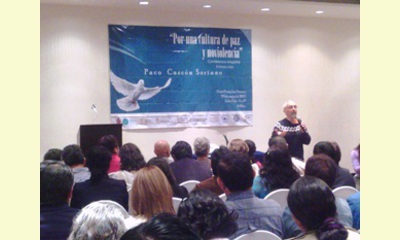|
|
Conference for a Culture of Peace and Non-Violence [Mexico]
un articulo por NSS Oaxaca (abridged)
"Peace is not the absence of conflict" - With
these words, Cascón Francisco Soriano begins his
Lecture "Conference for a Culture of Peace and
Non-Violence" organized by the Interagency Panel
on violence against children and adolescents, made
by the State Institute Oaxaca Public Education,
the Human Rights Ombudsman of the People of
Oaxaca, the Care Coordination for Human Rights of
the Government of the State of Oaxaca, Oaxaca DIF
System, the Ministry of Public Security, the
Attorney General of State Health Services of
Oaxaca and the State Council on the Rights of
Children and Adolescents in Oaxaca.

click on photo to enlarge
The program started at about 9 am, with a
participation of over 300 people, with the words
of the Executive Secretary of the National Council
for the Rights of Children and Adolescents in
Oaxaca, Maestra Blanca Castañón Canals,
Coordinator of the inter-institutional group
against violence to children and adolescents. She
referred to this event as "seeds of a long-term
project for education in a Culture of Peace to
increase protective factors against all kinds of
violence and to improve coexistence through
peaceful conflict regulation. "
Immediately afterwards came the main speaker,
Professor for the "Culture of Peace" Diploma of the
UNESCO Chair on Peace and Human Rights for Peace at
the Autonomous University of Barcelona. His lecture
covered the following themes:
1) Conflict and Violence are not the same.
Conflict is natural in human relationships;
2) Conflict can be an educational tool. Also, the
speaker identified those situations giving rise to
various forms of violence that can culminate in
extreme situations such as suicide and murder;
3) The steps that consolidate a process of
conflict resolution, and three errors involved in
conflict resolution: a) Waiting until the conflict
reaches the point of violence; b) Neglecting the
problem; c) failure to analyze the causes. He also
noted two types of models, cooperation and
resolution;
4) Aggression and violence. In this section, he
considered the various actors responsible for
promoting a culture of peace: family, school,
community and the media.
In the latter section he mentioned the difference
between aggression and violence, and he explained
the use of the term nonviolence, which comes from
the Sanskrit ahimsa. He noted that "NOT TO BE
VIOLENT" is not the same as to "BE NONVIOLENT" and
he defined a nonviolent person as someone
committed to Peace, Justice, Human Rights, taking
Gandhi as his reference.
He listed three types of violence: direct
violence, cultural violence and structural
violence. He explained, too, the difference
between the concepts of prevention and provention.
Preventing violence serves to generate violence
because it prevents conflict, which are natural.
Instead provention means providing strong
relationships constituted by confidence and
dialogue. . .
Upon completion of this process Professor Cascón
provided web pages where one can read materials on
Culture of Peace and Nonviolence: www.pacoc.pangea.org and www.edupaz.org .
(Click here for a Spanish version of this article.
|








|
DISCUSSION
Pregunta(s) relacionada(s) al artículo :
Does research show that nonviolence works?,
* * * * *
Comentario más reciente:
:
Did the writings on nonviolence by Gene Sharp help inspire the movements of the Arab Spring in Egypt and elsewhere?
This is debatable. The New York Times said "yes" and some Egyptians, for example, the blogger Karim Alrawi say "no".
However, it should be recognized that the ideas of nonviolent resistance have a way of transcending borders and centuries. Nelson Mandela was influenced by Martin Luther King who was influenced in turn by Mahatma Gandhi who was influenced in turn by Henry David Thoreau.
[Note added later: The blog of Karim Alrawi is no longer available on the Internet, but see instead the blog of Hossam El-Hamalawy who says that the Palestinians "have been the major source of inspiration, not Gene Sharp, whose name I first heard in my life only in February after we toppled Mubarak already and whom the clueless NYT moronically gives credit for our uprising."

|
|









